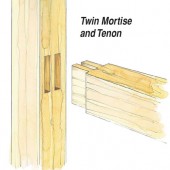
At what width would you suggest a twin tenon becomes advisable?
Andy Rae: Twin (or multiple) tenons aid wood movement in that they localize the amount of movement in a rail, reducing stress to the joint. A good rule of thumb is that any piece of wood over four inches wide (in just about any species and cut of wood, such as quarter sawn, rift, or plain sawn) will have sufficient movement across the grain to affect joint integrity in a cross-grain construction, such as in a mortise-and-tenon joint. Therefore, a four-inch wide tenon on a five-inch wide rail or apron is fine because wood movement is minimal. But in rails six inches or wider, it’s best to divide the tenons and house them in separate mortises.
Richard Jones: I think you mean a forked tenon, as you might see in the middle rail of an architectural frame and panel door. I consider forking the tenon where the rail is five inches wide or wider.
John Brock: I guess as a rule of thumb, I use a second tenon when the horizontal piece is as wide or wider than it is deep.





